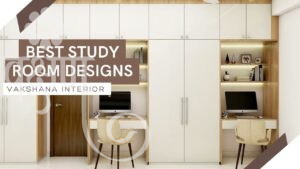Best Study Room Interior Designs: Creating a Space for Productivity and Inspiration
Best Study Room Interior Designs: Creating a Space for Productivity and Inspiration
Designing a study room that fosters productivity, creativity, and comfort is essential for students, professionals, and anyone who needs a dedicated space for focused work. Here, we’ll explore the best study room interior design ideas, touching on elements such as layout, furniture, lighting, color schemes, and decorative touches.
1. Layout and Space Planning
Optimized Layouts
- Dedicated Zones: Divide the study room into different zones for various activities such as reading, writing, computer work, and relaxation. This can be achieved with strategic placement of furniture and use of room dividers or rugs.
- Ergonomic Flow: Ensure the layout promotes ease of movement and accessibility. Place frequently used items within arm’s reach and ensure there is ample space to move around comfortably.
Space Utilization
- Vertical Storage: Utilize vertical space with shelves and wall-mounted storage to keep the floor area free and uncluttered.
- Multifunctional Furniture: Opt for furniture that serves multiple purposes, such as a desk with built-in storage or a convertible chair that doubles as a guest bed.
2. Furniture Selection
Essential Pieces
- Desks: Choose a desk that fits the user’s needs. A larger desk with ample surface area is ideal for those who need space for books, papers, and a computer. For smaller rooms, a wall-mounted desk or a compact writing table might be more suitable.
- Chairs: An ergonomic chair is crucial for maintaining good posture and comfort during long study sessions. Look for chairs with adjustable height, lumbar support, and comfortable padding.
Additional Furniture
- Bookshelves: Open bookshelves provide easy access to books and can also serve as display space for decorative items.
- Storage Units: Cabinets, drawers, and organizers help keep the study room tidy and clutter-free. Consider modular storage solutions that can be adjusted as needed.
3. Lighting
Natural Light
- Window Placement: Position the desk near a window to take advantage of natural light. Natural light boosts mood and productivity. Use sheer curtains or blinds to control glare and privacy.
Artificial Lighting
- Task Lighting: Desk lamps with adjustable arms and focused lighting are essential for reading and writing. Look for lamps with brightness control to reduce eye strain.
- Ambient Lighting: Overhead lights or wall-mounted fixtures provide general illumination. Choose energy-efficient LED lights with adjustable brightness.
- Accent Lighting: Use accent lighting to highlight specific areas or decorative elements. This can create a cozy and inviting atmosphere.
4. Color Schemes and Materials
Color Psychology
- Calm and Neutral Colors: Shades of blue, green, and neutral tones like beige and gray promote concentration and tranquility.
- Accent Colors: Introduce pops of color through accessories, artwork, or an accent wall to add energy and personality to the space.
Material Choices
- Natural Materials: Wood, bamboo, and natural fibers create a warm and inviting environment. These materials are also sustainable and environmentally friendly.
- Textured Surfaces: Incorporate textured surfaces like brick walls, corkboards, or fabric-covered boards to add visual interest and functionality.
5. Decorative Touches
Personalization
- Artwork and Posters: Displaying inspirational quotes, artwork, or posters can motivate and inspire. Choose pieces that resonate personally.
- Plants: Indoor plants add a touch of nature and improve air quality. Choose low-maintenance plants like succulents, snake plants, or pothos.
Functional Decor
- Bulletin Boards: Corkboards, whiteboards, or chalkboards are practical for pinning notes, schedules, and reminders.
- Organizers and Holders: Desk organizers, pen holders, and file racks keep essentials within reach and the workspace tidy.
6. Tech Integration
Cable Management
- Cord Organizers: Use cable organizers and clips to keep wires and cords untangled and out of sight.
- Charging Stations: Designate a charging station for electronic devices to keep them organized and powered up.
Smart Solutions
- Smart Lighting: Implement smart bulbs that can be controlled via smartphone or voice commands for convenience and energy efficiency.
- Ergonomic Gadgets: Consider ergonomic keyboards, mouse pads, and monitor stands to enhance comfort and productivity.
Conclusion
Designing the perfect study room involves balancing functionality, comfort, and aesthetics. By carefully considering layout, furniture, lighting, color schemes, and decorative touches, you can create a study space that not only supports productivity but also inspires and motivates. Whether it’s a small corner in a living room or a dedicated home office, thoughtful design can transform any space into an ideal environment for learning and working.





